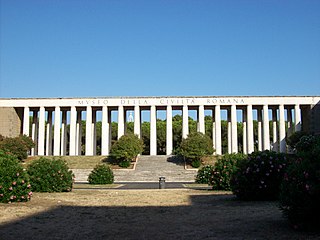
Bagpipes are a woodwind instrument using enclosed reeds fed from a constant reservoir of air in the form of a bag. The Great Highland bagpipes are well known, but people have played bagpipes for centuries throughout large parts of Europe, Northern Africa, Western Asia, around the Persian Gulf and northern parts of South Asia.

Lodi is a city and comune in Lombardy, northern Italy, primarily on the western bank of the River Adda. It is the capital of the province of Lodi.

Zampogna is a generic term for a number of Italian double chantered bagpipes that can be found as far north as the southern part of the Marche, throughout areas in Abruzzo, Latium, Molise, Basilicata, Campania, Calabria, Apulia and Sicily. The tradition is now mostly associated with Christmas, and the most famous Italian carol, "Tu scendi dalle stelle" is derived from traditional zampogna music. However, there is an ongoing resurgence of the instrument in secular use seen with the increasing number of folk music festivals and folk music ensembles.

Volterra is a walled mountaintop town in the Tuscany region of Italy. Its history dates from before the 8th century BC and it has substantial structures from the Etruscan, Roman, and Medieval periods.

The Bargello, also known as the Palazzo del Bargello or Palazzo del Popolo, is a former barracks and prison in Florence, Italy. Since 1865, it has housed the Museo Nazionale del Bargello, a national art museum.

The Museum of the Roman Civilization is a museum in Rome, devoted to aspects of the Ancient Roman Civilization.

Scapoli is a town and comune located in province of Isernia, which is part of the region of Molise, southern Italy. As of 2011 it had a population of 758.
While it is one of the smallest regions of Italy, the Music of Molise is active.

Vittorio Valletta was an Italian industrialist and president of Fiat S.p.A. from 1946 to 1966.

Vietri sul Mare is a town and comune in the province of Salerno, in the Campania region of southern Italy. It is situated just west of Salerno, separated from the Port of Salerno by only a harbour wall. The town is known for its polychrome ceramics, a tradition since at least the 15th century, and is considered to be the gateway to the Amalfi Coast.

The Museo Nazionale della Magna Grecia, Museo Archeologico Nazionale di Reggio Calabria or Palazzo Piacentini is a museum in Reggio Calabria, southern Italy, housing an archaeological collection from sites in Magna Graecia.

The baghèt is a bagpipe historically played in Bergamo, corresponding to the region of Lombardy in modern Italy. It is a small double-reeded bagpipe with two drones, associated with rural musicians. The instrument became defunct in the mid-20th century, but is now played by some revivalists.

The Palazzo Riso, or RISO, Museo d’Arte Contemporanea della Sicilia, is a regional contemporary art museum located in the ancient Corso Vittorio Emanuele, Palermo, Italy.

Tre Sassi fort is a fortress and museum on the road to the Passo di Valparola, within the comune of Cortina d'Ampezzo in the southern (Dolomitic) Alps of the Veneto region of Northern Italy. Hidden between the Ampezzo valley and the high Val Badia, it was built by Austrians between 1897 and 1901 as a fortification against attack from the Italians on the Falzàrego and Valparo. During World War I it was a favorite target for the Italians, and the fort was destroyed as there was inadequate artillery to defend it.

Ptolemy Philadelphus in the Library of Alexandria is an 1813 oil on canvas painting by Vincenzo Camuccini. It is now in the National Museum of Capodimonte in Naples.

Assumption of the Virgin with Saint John the Baptist and Saint Catherine of Alexandria is an oil on panel painting by Fra Bartolomeo, created c. 1516, commissioned by the church of Santa Maria in Castello in Prato. To the left of the Virgin's tomb is John the Baptist, whilst to the right is Catherine of Alexandria. It is now in the National Museum of Capodimonte in Naples.

Allegory of Justice is an oil-on-panel painting by the Italian Renaissance artist Giorgio Vasari. The painting was commissioned on 6 January 1543 by cardinal Alessandro Farnese for the main room of the Palazzo della Cancelleria in Rome, and was executed the same year. It and the rest of the Farnese collection were later moved to Naples and it is now in the National Museum of Capodimonte.

Ugo Giletta is an Italian artist.

The Casa Vasari is a building at 55 via XX Settembre in Arezzo, Tuscany, Italy. It was the family home of the painter, art historian and architect Giorgio Vasari. It houses a number of frescoes and since December 2014 the Italian Ministry of Culture has run it through the Polo museale della Toscana, which was renamed the Direzione regionale Musei in December 2019. It houses the Archivio Vasariano.



















